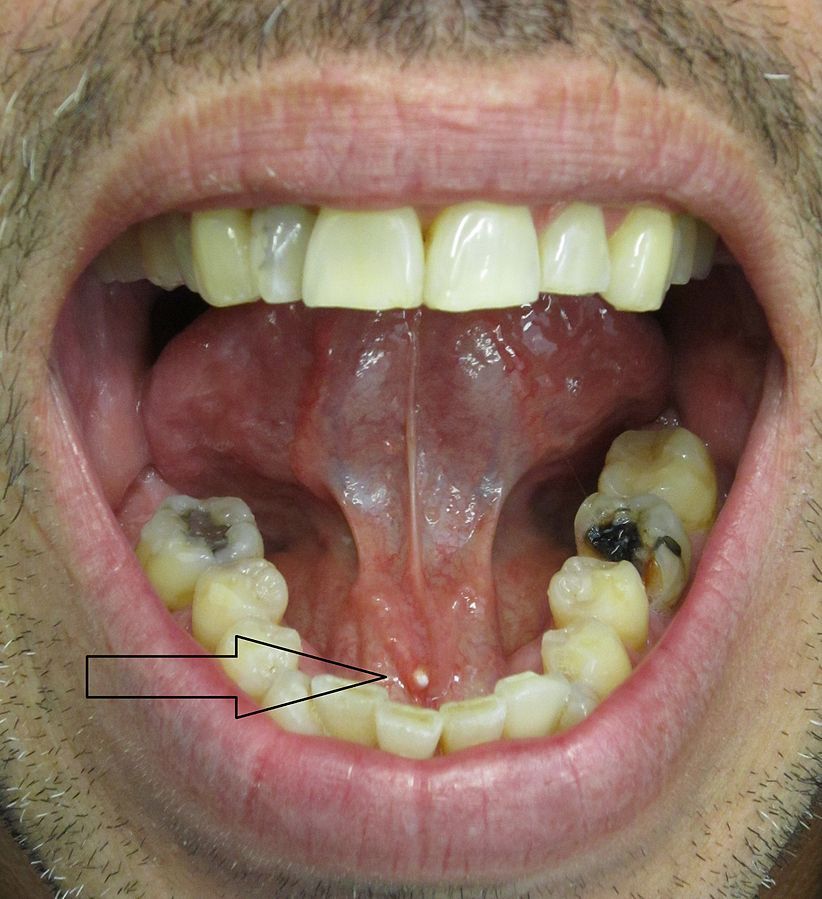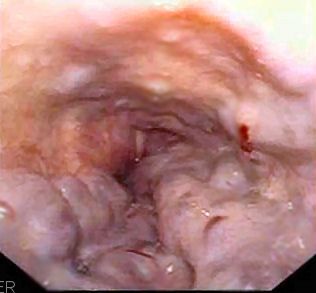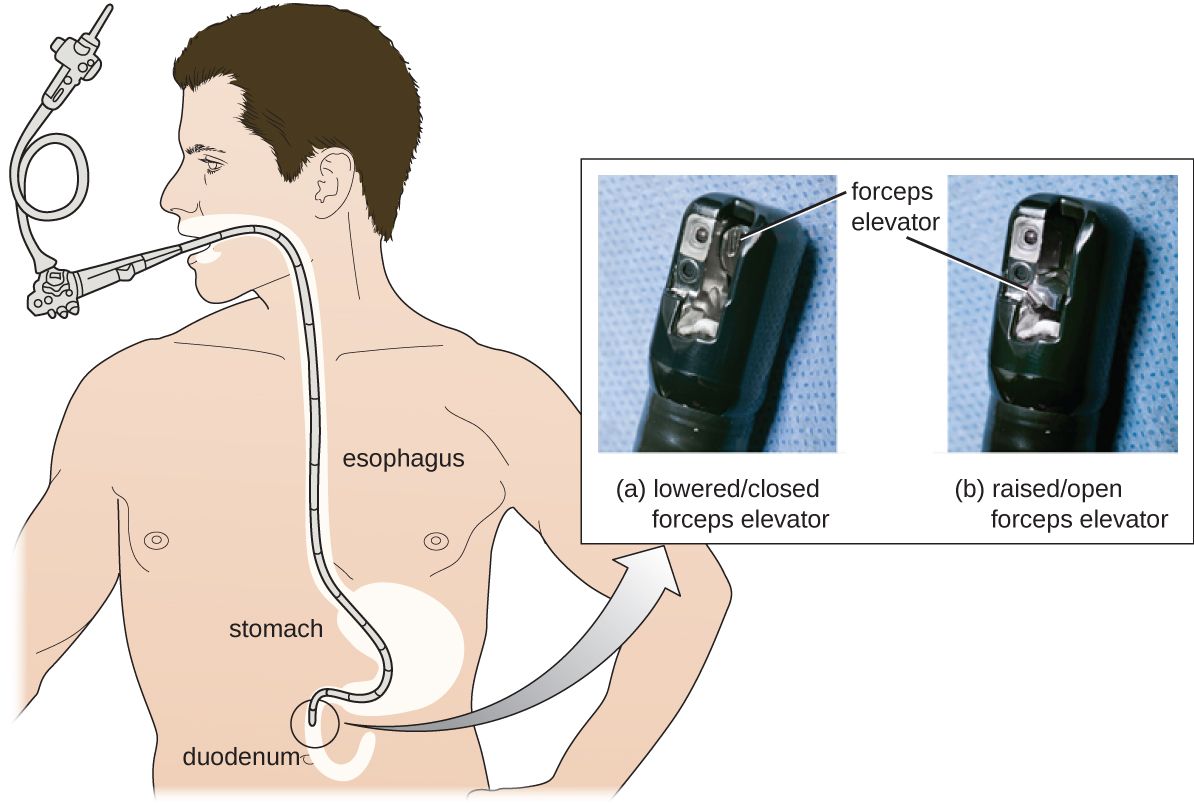Next Lesson - Hepatic, Biliary and Pancreatic Pathology
Core
Sialolithiasis is the medical term for stones in the salivary glands or the salivary ducts that pass saliva from the glands into the mouth. The calculi (stones) are mainly composed of calcium phosphate but can contain a variety of other compounds such as urate. The calculi can be formed in any salivary gland; submandibular (most common), parotid or sublingual.
Risk factors include:
- Dehydration – lower water content in saliva increases concentration which predisposes to stones
- Gout – high uric acid levels can predispose to urate stones
- Smoking
- Hyperparathyroidism – hypercalcaemia can predispose to calcium phosphate stones
- Anti-cholinergic medications
This condition can be asymptomatic or may present with intermittent pain (often when eating as this is when saliva is released) or intermittent facial swelling. Symptoms are usually unilateral.
Diagnosis of this condition is usually made based on history and examination but if further investigation is required, the majority of salivary calculi (around 80%) are radio-opaque so a sialogram (x-ray) can be used.
Conservative management is to increase salivation with citrus fruit consumption to dislodge the stone alongside analgesia to manage the pain. If this is unsuccessful a minor operation to remove the stone may be required. In cases of recurrent sialolithiasis, the salivary gland producing the calculi may have to be removed but this is uncommon.

Image - Patient with submandibular sialolithiasis
Creative commons source by James Heilman, MD [CC BY-SA 4.0 (https://creativecommons.org/licenses/by-sa/4.0)]
Oesophageal varices are dilated veins located in the distal third of the oesophageal mucosa. They are a complication of portal hypertension and therefore risk factors are the same as those for liver disease and cirrhosis. Oesophageal varices are asymptomatic. They are usually diagnosed by oesophagogastroduodenoscopy (OGD).
Unfortunately, oesophageal varices are often only identified when the patient presents with an upper gastrointestinal (GI) bleed. If the patient is known to have oesophageal varices prior to this, non-selective beta-blockers and nitrates have been shown to reduce the chances of an upper GI bleed in these patients.

Image - View of oesophageal varices via oesophagogastroduodenoscopy
Creative commons source by Samir [CC BY-SA 4.0 (https://creativecommons.org/licenses/by-sa/4.0)]
For more information on Portal hypertension, please see the Hepatic, Biliary and Pancreatic Pathology article.
For more information on Upper GI bleeds, please see the Gastrointestinal Emergencies article.
A Mallory Weiss tear is a tear of the mucous membrane of the oesophagus. It is not a full rupture of the oesophagus, that is a different condition known as Boerhaave’s syndrome.
Risk factors for a Mallory Weiss tear are binge drinking, chronic alcoholism, and bulimia. This is because these tears are most commonly caused by severe retching and/or vomiting. There are other causes that also increase the intra-oesophageal pressure such as chronic hiccups, severe coughing, straining etc. However, these are much less common.
Patients typically present with severe vomiting, haematemesis and epigastric/retrosternal pain. This haematemesis may present with bright red blood, or partially digested blood known as coffee-ground vomiting, depending on how long the blood was present in the digestive tract. They may also have associated melaena (the passage of digested blood through the rectum).
If the patient is stable, oesophagogastroduodenoscopy (OGD) is used to diagnose the Mallory Weiss tear. Management ranges from supportive treatment until bleeding resolves to cauterisation, vasopressive drugs (e.g. adrenaline) and/or a balloon tamponade with a Sengstaken–Blakemore tube; all dependent on the extent of the bleeding.
Gastro-oesophageal Reflux Disease (GORD)
Gastro-oesophageal reflux disease (GORD) is also known as acid reflux. It is a condition where stomach acid rises up into the oesophagus.
Risk factors include:
- Hiatus hernia
- Smoking
- High alcohol intake
- Obesity
- Pregnancy
- Family history
- High fatty food intake
- Stress/anxiety
- Drug use (e.g. long-term antibiotic use or NSAID use)
Patients typically present with retrosternal pain (heartburn), metallic taste in the back of the throat and halitosis. Less commonly they may have an associated cough, wheeze, or hoarse voice. Diagnosis is based on history usually but OGD may be used if conservative management does not improve symptoms or complications are suspected.
Management of GORD is lifestyle advice to eliminate previously mentioned risk factors alongside a proton pump inhibitor (PPI), e.g. omeprazole, for 4-8 weeks.
Oesophagitis is a complication of GORD where the oesophagus becomes inflamed. There are causes of oesophagitis other than GORD such as an infection, however, this is rare.
Oesophagitis can be asymptomatic, but may cause epigastric/retrosternal pain or dysphagia. Initial management is the same as for GORD, however, in severe cases of oesophagitis, surgical intervention may be required to repair/remove damaged parts of the oesophagus.

Diagram - The process of oesophagogastroduodenoscopy
Creative commons source by CNX OpenStax [CC BY-SA 4.0 (https://creativecommons.org/licenses/by-sa/4.0)]
An oesophageal stricture is a narrowing of the oesophagus most commonly linked to GORD, oesophagitis and hiatus hernias. It can present with symptoms similar to GORD as well as dysphagia, odynophagia, choking, coughing, burping and weight loss. It is investigated by OGD or a barium swallow x-ray.
Management involves treating the cause (e.g. GORD management) as well as stretching or stenting the oesophagus to prevent continued dysphagia.
Barrett’s oesophagus is a complication of oesophagitis caused by GORD. It occurs when there is a metaplastic change in the cells lining the lower third of the oesophagus from stratified squamous epithelium (the normal epithelium of the oesophagus) to simple columnar epithelium (epithelium more similar to the stomach). This occurs as a protective mechanism from the acid that is refluxing into the oesophagus.
Risk factors and symptoms are the same as that of oesophagitis caused by GORD. It is diagnosed by OGD where a clear change in the appearance of the oesophagus can be seen.
Barrett’s oesophagus is metaplasia not neoplasia, but this change is considered a pre-malignant condition because it is often a precursor to adenocarcinoma of the oesophagus. As a result, patients with this condition undergo regular OGD surveillance in order to identify further changes early.
Gastritis is the inflammation of the lining of the stomach and may be acute or chronic.
Patients often present with stomach pain, nausea, acid reflux/associated GORD or in more severe cases there can be melaena or haematemesis if a peptic ulcer has formed and/or perforated. Perforated ulcers are discussed further in the ‘Gastrointestinal Emergencies’ article.
Gastritis can be caused by:
- Helicobacter pylori – increase gastrin and acid levels in the stomach. H. pylori are adapted to survive in the low pH of the stomach as they produce urease which converts urea to ammonia and they also have good motility in the mucus layer of the stomach lining.
- NSAIDs – inhibit the prostaglandins which would normally maintain blood flow to the mucosa of the stomach, leading to reduced perfusion.
- Heavy alcohol use – dissolves the protective mucous layer of the stomach.
- Autoimmune conditions
Gastritis is a clinical diagnosis in itself, but a ‘Urea breath test’ can be performed to identify if H. pylori infection is the cause once other risk factors for the condition have been excluded.
Treatment for gastritis involves removal of risk factors (e.g. stop drinking alcohol, stop using NSAIDs etc.), and triple therapy for eradication of H. pylori (Metronidazole + Amoxicillin + PPI). If medical treatment is unsuccessful further investigation with endoscopy will likely be required +/- surgical intervention.
Edited by: Dr. Maddie Swannack
Reviewed by: Dr. Thomas Burnell
- 131

